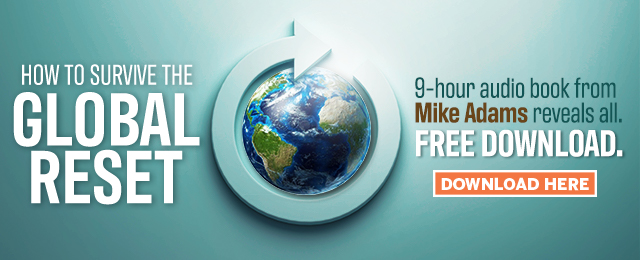
The Atkins Diet Food Guide Pyramid, Part 4: The Importance of Exercise
 Sunday, July 18, 2004 Sunday, July 18, 2004by Mike Adams, the Health Ranger Editor of NaturalNews.com (See all articles...) Tags: Atkins Diet, Food Guide Pyramid, low-carb diet |
- Solar storm sparks concern as supervolcano nears eruption: Could sun's electromagnetic pulse trigger cataclysm?
- Mysterious hexagonal UFO sighting over California sparks questions amid government secrecy
- Gum bacteria invade heart, trigger dangerous heart rhythm problems
- “Cancer-Free with Food”: A culinary revolution in the fight against disease
- ANOTHER Clinton associate, who vowed to expose elite pedophile ring, found dead
- Trump’s Gulf tour sparks Iran nuclear deal breakthrough amid regional shifts
- WHO's PANDEMIC AGREEMENT just a ploy to CONTROL every aspect of any SCAMDEMIC they declare at any time and indefinitely
- Zero-waste bean cooking: Repurposing pinto bean broth in soups or bread
- CDC's dangerous gamble: Pregnant women and their unborn babies at put at unreasonable RISK from SIX toxic vaccines
- Forever chemicals” invade Australian water supply: Investigation yields torrent of carcinogens, signifying vast regulatory failure
- L.A. edges closer to historic $30 minimum wage for tourism workers amid backlash
- EXPENSIVE CANCER THERAPY promoted in New Zealand while ignoring the very CAUSE of their shockingly high rate of lymphoma cases
- Saw Palmetto: The mighty berry for men's health and beyond
- Florida bans toxic fluoride in tap water, protecting citizens from forced medication
- Peanut oil: A superfood source of healthy fats to support your heart
- Trump administration probes publisher of influential COVID origins paper over alleged Fauci influence
- Consumer Reports finds high levels of LEAD in cassava products
- Hidden poison in your medicine and supplements: How phthalates in capsules are silently attacking your heart, thyroid, and hormones
- WAR ON COGNITION: The Coordinated Assault on Your Brain and How to Defend Yourself Against Every Attack
- Canada's COVID cover-up: Health officials swore secrecy to protect Trudeau from vaccine scandal
- Singapore's draconian vaccine mandate: Citizens face jail time for refusing FORCED medical procedures that do HARM
- Big Pharma's Dirty Secret: How Prescription Drugs Are Starving Your Body of Essential Nutrients
- Gene-edited pork sneaks onto your plate: FDA quietly approves CRISPR pigs amid health and ethical concerns
- RED ALERT: Nuclear War Between India and Pakistan Could Trigger Global Catastrophe… full RISK ANALYSIS
- JESUS NEVER SPOKE ENGLISH: Historical facts on why the Bible you’re probably reading has been altered, redacted or hidden from much of its original meaning
- Hidden poison in your medicine and supplements: How phthalates in capsules are silently attacking your heart, thyroid, and hormones
- BBC accused of “political censorship” for shelving Gaza documentary amid mounting pressure
- Brushing with poison: Study finds toxic heavy metals in 90% of toothpaste brands, including those for children
- Australia’s vaccine cover-up: 35 died same day as COVID shot, but authorities ignored them
- Why All Government Officials and Big Tech CEOs Who Engage in Systematic Viewpoint Censorship Must Be ARRESTED, Prosecuted, and Sentenced to Life in Prison
- Silent catastrophe: COVID-19 vaccines linked to plummeting fertility rates, Czech data reveals
- Survival basics: 5 Dangerous locations to avoid during an EMP attack
- X-class solar flare sparks worldwide disruptions, with more storms expected as sunspot turns toward Earth
- The truth about Benzyl Alcohol in beauty products
- DOJ targets controversial “Proximal Origin” study in push for scientific transparency
- Landmark study of 85 million reveals shocking surge in heart attacks, strokes, and sudden death following the notorious COVID-19 jab
- The Miraculous Healing Power of DMSO: Nature's Forgotten Cure for Cancer, Pain, and Regeneration
- Biblical truth: God will carry out a “cosmic reset” of Earth and destroy all human civilization with a series of extinction-level cosmic impacts known as The Seven Trumpets, Seven Bowls and Seven Seals
- URGENT REPORT: The China Import Embargo - What to Stockpile Now Before America Runs Out
- The Ultimate Survival Guide to Baking Soda: A Miraculous, Multi-Purpose Remedy for Health, Home, and Emergency Preparedness
- A call to preserve America’s future: “Defeating Big Government Socialism” by Newt Gingrich
- Stunning Visualization of the Seven Trumpets in the Book of Revelation
- Big Pharma launches “Vaccine Integrity Project” to combat Secretary Kennedy and keep 94 shots going into kids with mandates and liability protections
- World Economic Forum's current downfall exposes legacy of totalitarianism, financial fraud, and crimes against humanity
- Widespread social and economic unrest: Steve Quayle issues urgent financial warning of imminent asset collapse in new interview with Mike Adams
- Aerosolized bioweapons? Strange “diploid biomasses” falling out of the sky in Florida captured under the microscope
- Biden regime deployed over 600 grants to fund disinformation agenda, to silence the truth and stifle debate
- The Miraculous Healing Power of Green Tea: Unlocking the Potent Antioxidants That Big Pharma Doesn't Want You to Know About
- The unspoken truth about chemotherapy: These “treatments” create toxic time bombs in your body called CELL-KILLING PARTICLES
- U.S. Government's Bio-War Against America: 15 Historical Medical Horrors Inflicted on the American People by the Government Itself
- A win for free speech: State Department SHUTS DOWN controversial disinformation office
- French rioting demonstrates how gun control laws are failing law-abiding citizens
- Head of L.A. Port warns of incoming plunge in U.S. supply chain, empty shelves and inventory depletion in 5-7 weeks
- Supreme Court to review challenge to Illinois’ semi-automatic gun ban
- Red Cross issues warning to stop blood plasma donations from vaccinated people
- Scientists confirm: GENIUS brain function can be spontaneously unleashed in humans without any apparent cause
- EPA advisor admits the agency is funneling billions to climate groups ahead of Trump’s return to White House
- HYSSOP: What research reveals about the health benefits of this ancient holy herb
- Two containers with completed ballots fall out of truck in Florida
- Newly released JFK files reveal Pentagon's role in creating Lyme disease and covid in the same lab
- Mike Adams releases country western hit single: Goin’ Back in Time is Comin’ Home
- Global leaders unite to clamp down on “misinformation” with UN-backed Cascais Declaration
- BREAKING: 2025 NDAA authorizes mandatory military draft of WOMEN across America… as Pentagon pursues global NUCLEAR war with both Russia and China at the same time
- I Want My Bailout Money – new song released by Mike Adams
- Michael Yon warns of a ZIONIST TAKEOVER in Trump’s second administration
- Ozempic and Wegovy weight loss drugs are injectable LIZARD VENOM PEPTIDES that may unleash a devastating wave of organ failure… side effects align with symptoms of SNAKE BITES
- BOMBSHELL: DNA testing kits are a SCAM to develop ethnic-specific bioweapons
- The Health Ranger releases “Vaccine Zombie” song and music video, using AI-animated zombies for the music video
- These 13 countries just signed an agreement to engineer a global FAMINE by destroying food supply
- Israeli soldiers accused of even more torture and abuse in the West Bank
- RFK Jr. clears key hurdle: Sen. Susan Collins backs controversial HHS nominee, signaling a new era for health policy
- Sermon 30: How Jesus reveals Caesar’s FAKE CURRENCY and FALSE AUTHORITY
Why? Because the human body was designed to be put to daily use. Unlike automobile parts that wear out the more you use them, body parts get better the more you use them. By flexing muscles, massaging lymph nodes through movement, moving the walls of blood vessels, providing stresses to bones, and increasing the heart rate through exercise, a person unleashes a windfall of healthy biochemical and physical effects that are fundamental to achieving a state of optimum health. Without exercise, achieving lasting health is simply not possible.
And this is where many Atkins dieters make a wrong turn. Instead of making physical exercise part of their overall health strategy, they may tend to rely on food choices alone, thinking that if they just avoid dietary carbohydrates, they don't need to exercise! It's a distortion, of course, since physical exercise is essential for low-carb diet success. I explain why in great detail in the exercise and strength training section of Low-Carb Diet Warning. The Atkins pyramid clearly support the idea that carbs and grains can only be consumed by a person who engages in frequent exercise.
In this way, the Atkins pyramid is right on target: frequent exercise allows you the "luxury," if you will, of consuming additional carbohydrates. Yet the underlying physiological realities that support this notion go far beyond what most people realize. The general consensus is that more physical exercise allows you to eat more carbs simply because you've burned off that many calories during your exercise. But that's not the real reason at all.
Without exercise, the human body isn't biochemically configured to process carbohydrates. Clinical research shows that a sedentary body will have an exaggerated insulin response to even mild carbohydrates (such as a bowl of oatmeal), where a body subjected to regular exercise will easily and unnoticeably metabolize those carbohydrates without elevating insulin levels. In other words, frequent exercise "reprograms" your body's instructions on how to deal with dietary carbohydrates. A person who engages in regular exercise is truly able to consume more carbs than a person who avoids exercise, without showing any adverse insulin effects. The degree to which an individual response to exercise, of course, varies considerably, which is why the Atkins pyramid states, in the footnotes, "Everyone's metabolism and lifestyle are different. Discover your individual carb level to achieve and maintain a healthy weight."
Despite all this, the fact remains that most low-carb dieters continue to avoid physical exercise. I see this as a real problem based on all the email feedback I've received from readers. The strange thing is that most low-carb dieters realize they should exercise more, but they avoid it anyway. They intellectually agree with the "exercise more" philosophy, but can't seem to whip their hips into action and get the exercise done.
I've especially noticed a pattern of avoidance of strength training with women. Women need strength training more than men, by the way, and older women need it more yet. In fact, the Atkins diet typically results in a greatly increased need to engage in strength training in order to protect the bones against the highly acidic nature of heavy protein consumption. Without exercise, part of a low-carb dieter's weight loss may actually result from bone mass loss! This leads, of course, to osteoporosis. For a more detailed explanation, read the strength training and bone density section of Low-Carb Diet Warning.
Another place where people distort the true intention of the Atkins pyramid is by thinking that ten minutes of walking allows them to eat a jelly donut. This is a fairly typical distortion, actually, where the proportion of exercise to carbohydrates is wildly distorted in the minds of low-carb dieters who absolutely hate exercise and love jelly donuts! In reality, no amount of exercise justifies a jelly donut, and it would take a full hour of fast-paced walking to justify even a single slice of regular bread. It takes a lot more exercise to justify eating carbs than most people realize. So it's easy for people to incorrectly interpret this exercise component of the Atkins pyramid and end up engaging in bizarre dietary practices just because they walked up a few flights of stairs, for example.
Still, hats off to the Atkins team for adding this element. When properly understood and followed by Atkins dieters, it is nothing short of genius. As a low-carb dieter, just remember that the volume and frequency of exercise required to justify additional fruits, nuts and breads is probably much larger than you think. In my own experience, I wasn't able to eat breads without producing insulin spikes until I was engaging in a solid five hours a week of what most people would consider to be aggressive exercise: biking at 15 - 20 miles per hour, climbing the Stairmaster, and jogging. Even now, I don't dare touch bread unless it's that oh-so-chewy low-carb bread.
This article is reprinted from Analysis: The Atkins Lifestyle Food Guide Pyramid, a public education ebook provided free of charge by the non-profit Consumer Wellness Research Center.
Atkins Diet at FETCH.news
Get independent news alerts on natural cures, food lab tests, cannabis medicine, science, robotics, drones, privacy and more.
 About the author:Mike Adams (aka the "Health Ranger") is a best selling author (#1 best selling science book on Amazon.com) and a globally recognized scientific researcher in clean foods. He serves as the founding editor of NaturalNews.com and the lab science director of an internationally accredited (ISO 17025) analytical laboratory known as CWC Labs. There, he was awarded a Certificate of Excellence for achieving extremely high accuracy in the analysis of toxic elements in unknown water samples using ICP-MS instrumentation. Adams is also highly proficient in running liquid chromatography, ion chromatography and mass spectrometry time-of-flight analytical instrumentation.
About the author:Mike Adams (aka the "Health Ranger") is a best selling author (#1 best selling science book on Amazon.com) and a globally recognized scientific researcher in clean foods. He serves as the founding editor of NaturalNews.com and the lab science director of an internationally accredited (ISO 17025) analytical laboratory known as CWC Labs. There, he was awarded a Certificate of Excellence for achieving extremely high accuracy in the analysis of toxic elements in unknown water samples using ICP-MS instrumentation. Adams is also highly proficient in running liquid chromatography, ion chromatography and mass spectrometry time-of-flight analytical instrumentation.
Adams is a person of color whose ancestors include Africans and Native American Indians. He's also of Native American heritage, which he credits as inspiring his "Health Ranger" passion for protecting life and nature against the destruction caused by chemicals, heavy metals and other forms of pollution.
Adams is the founder and publisher of the open source science journal Natural Science Journal, the author of numerous peer-reviewed science papers published by the journal, and the author of the world's first book that published ICP-MS heavy metals analysis results for foods, dietary supplements, pet food, spices and fast food. The book is entitled Food Forensics and is published by BenBella Books.
In his laboratory research, Adams has made numerous food safety breakthroughs such as revealing rice protein products imported from Asia to be contaminated with toxic heavy metals like lead, cadmium and tungsten. Adams was the first food science researcher to document high levels of tungsten in superfoods. He also discovered over 11 ppm lead in imported mangosteen powder, and led an industry-wide voluntary agreement to limit heavy metals in rice protein products.
In addition to his lab work, Adams is also the (non-paid) executive director of the non-profit Consumer Wellness Center (CWC), an organization that redirects 100% of its donations receipts to grant programs that teach children and women how to grow their own food or vastly improve their nutrition. Through the non-profit CWC, Adams also launched Nutrition Rescue, a program that donates essential vitamins to people in need. Click here to see some of the CWC success stories.
With a background in science and software technology, Adams is the original founder of the email newsletter technology company known as Arial Software. Using his technical experience combined with his love for natural health, Adams developed and deployed the content management system currently driving NaturalNews.com. He also engineered the high-level statistical algorithms that power SCIENCE.naturalnews.com, a massive research resource featuring over 10 million scientific studies.
Adams is well known for his incredibly popular consumer activism video blowing the lid on fake blueberries used throughout the food supply. He has also exposed "strange fibers" found in Chicken McNuggets, fake academic credentials of so-called health "gurus," dangerous "detox" products imported as battery acid and sold for oral consumption, fake acai berry scams, the California raw milk raids, the vaccine research fraud revealed by industry whistleblowers and many other topics.
Adams has also helped defend the rights of home gardeners and protect the medical freedom rights of parents. Adams is widely recognized to have made a remarkable global impact on issues like GMOs, vaccines, nutrition therapies, human consciousness.
In addition to his activism, Adams is an accomplished musician who has released over a dozen popular songs covering a variety of activism topics.
Click here to read a more detailed bio on Mike Adams, the Health Ranger, at HealthRanger.com.
Take Action: Support Natural News by linking to this article from your website
Permalink to this article:
Embed article link: (copy HTML code below):
Reprinting this article:
Non-commercial use OK, cite NaturalNews.com with clickable link.
Follow Natural News on Facebook, Twitter, Google Plus, and Pinterest
Science News & Studies
Medicine News and Information
Food News & Studies
Health News & Studies
Herbs News & Information
Pollution News & Studies
Cancer News & Studies
Climate News & Studies
Survival News & Information
Gear News & Information
News covering technology, stocks, hackers, and more



"Big Tech and mainstream media are constantly trying to silence the independent voices that dare to bring you the truth about toxic food ingredients, dangerous medications and the failed, fraudulent science of the profit-driven medical establishment.
Email is one of the best ways to make sure you stay informed, without the censorship of the tech giants (Google, Apple, Facebook, Twitter, YouTube, etc.). Stay informed and you'll even likely learn information that may help save your own life."
–The Health Ranger, Mike Adams













































